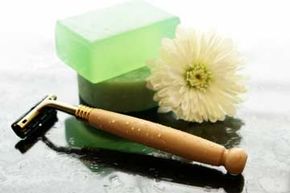Shaving is an activity that many men and women have in common, even if the part of the body being shaved varies. But are the products and techniques interchangeable across the gender divide?
Let's start by looking at the differences between male and female skin. Men usually have larger pores, thicker skin and more active sebaceous glands [source: Waters and Fitzgerald]. Those glands produce less oil over time regardless of whether you're male or female, but the levels drop further for women than they do for men [source: Oakley]. As a result, men's hair is more naturally conditioned than women's for a greater length of time. Hormones play a part, too, when it comes to skin and hair; male hormones, or androgens, stimulate the growth of facial and body hair in both men and women. The higher your androgen levels, the thicker your hair [source: American Association for Clinical Chemistry]. Women tend to have less body hair overall compared with men; however, excess levels of androgens in women can lead to a condition called hirsutism, which is characterized by thick body hair [source: American Academy of Family Physicians].
Advertisement
But what does this mean for shaving? Does hair thickness really make a big difference when it comes to the products you use? Most shaving creams, regardless of whether they're marketed for men or for women, will work in similar ways on your skin. Shaving creams are primarily made up of moisturizers, softeners and chemicals cleansers. The differences are in the aesthetics: Shaving foam for men tends to be white, with a more woodsy smell, whereas women's products are more likely to come in pastel colors and have floral or fruity scents. Packaging is generally the only big difference in bladed razors, too.
The biggest difference between shaving for men and shaving for women lies in the technique. One factor is the body part that's being shaved. The skin on your legs, for example, is less sensitive than the skin on your face. As a result, shaving against the grain is more common on the legs, whereas doing so on your face is apt to result in ingrown hairs and razor burn [source: Waters and Fitzgerald]. And hormones play a factor here, too, because thicker hair is more difficult to remove and its regrowth is more noticeable.
So, even though the products men and women often use to shave might be interchangeable, there are still big differences in the process itself, depending on which part of the body is being shaved. Learn even more about shaving by following the links on the next page.
Advertisement


